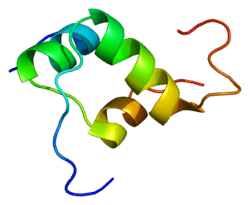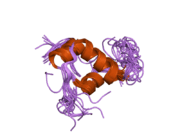INSL3
| INSL3 | |||||||||||||||||
|---|---|---|---|---|---|---|---|---|---|---|---|---|---|---|---|---|---|
 |
|||||||||||||||||
| |||||||||||||||||
| Identifiers | |||||||||||||||||
| Aliases | INSL3, RLF, RLNL, ley-I-L, insulin like 3 | ||||||||||||||||
| External IDs | MGI: 108427 HomoloGene: 4048 GeneCards: INSL3 | ||||||||||||||||
| |||||||||||||||||
| Orthologs | |||||||||||||||||
| Species | Human | Mouse | |||||||||||||||
| Entrez | |||||||||||||||||
| Ensembl | |||||||||||||||||
| UniProt | |||||||||||||||||
| RefSeq (mRNA) | |||||||||||||||||
| RefSeq (protein) |
| ||||||||||||||||
| Location (UCSC) | Chr 19: 17.82 – 17.82 Mb | Chr 8: 71.69 – 71.69 Mb | |||||||||||||||
| PubMed search | [1] | [2] | |||||||||||||||
| Wikidata | |||||||||||||||||
| View/Edit Human | View/Edit Mouse |
Insulin-like 3 is a protein that in humans is encoded by the INSL3 gene.[3][4]
The protein encoded by this gene is an insulin like hormone produced mainly in gonadal tissues in males and females. Studies of the mouse counterpart suggest that this gene may be involved in the development of urogenital tract and female fertility. It may also act as a hormone to regulate growth and differentiation of gubernaculum, and thus mediating intra-abdominal testicular descent. The mutations in this gene may lead to, but not a frequent cause of, cryptorchidism.[4]
References
- ↑ "Human PubMed Reference:".
- ↑ "Mouse PubMed Reference:".
- ↑ Burkhardt E, Adham IM, Brosig B, Gastmann A, Mattei MG, Engel W (Jul 1994). "Structural organization of the porcine and human genes coding for a Leydig cell-specific insulin-like peptide (LEY I-L) and chromosomal localization of the human gene (INSL3)". Genomics. 20 (1): 13–9. doi:10.1006/geno.1994.1121. PMID 8020942.
- 1 2 "Entrez Gene: INSL3 insulin-like 3 (Leydig cell)".
Further reading
- Lai KS, Jin Y, Graham DK, et al. (1995). "A kinase-deficient splice variant of the human JAK3 is expressed in hematopoietic and epithelial cancer cells". J. Biol. Chem. 270 (42): 25028–36. doi:10.1074/jbc.270.42.25028. PMID 7559633.
- Macchi P, Villa A, Giliani S, et al. (1995). "Mutations of Jak-3 gene in patients with autosomal severe combined immune deficiency (SCID)". Nature. 377 (6544): 65–8. doi:10.1038/377065a0. PMID 7659163.
- Tashima LS, Hieber AD, Greenwood FC, Bryant-Greenwood GD (1995). "The human Leydig insulin-like (hLEY I-L) gene is expressed in the corpus luteum and trophoblast". J. Clin. Endocrinol. Metab. 80 (2): 707–10. doi:10.1210/jc.80.2.707. PMID 7852540.
- Witthuhn BA, Silvennoinen O, Miura O, et al. (1994). "Involvement of the Jak-3 Janus kinase in signalling by interleukins 2 and 4 in lymphoid and myeloid cells". Nature. 370 (6485): 153–7. doi:10.1038/370153a0. PMID 8022486.
- Kawamura M, McVicar DW, Johnston JA, et al. (1994). "Molecular cloning of L-JAK, a Janus family protein-tyrosine kinase expressed in natural killer cells and activated leukocytes". Proc. Natl. Acad. Sci. U.S.A. 91 (14): 6374–8. doi:10.1073/pnas.91.14.6374. PMC 44204
 . PMID 8022790.
. PMID 8022790. - Burkhardt E, Adham IM, Hobohm U, et al. (1994). "A human cDNA coding for the Leydig insulin-like peptide (Ley I-L)". Hum. Genet. 94 (1): 91–4. doi:10.1007/BF02272850. PMID 8034302.
- Adham IM, Burkhardt E, Benahmed M, Engel W (1994). "Cloning of a cDNA for a novel insulin-like peptide of the testicular Leydig cells". J. Biol. Chem. 268 (35): 26668–72. PMID 8253799.
- Verbsky JW, Bach EA, Fang YF, et al. (1996). "Expression of Janus kinase 3 in human endothelial and other non-lymphoid and non-myeloid cells". J. Biol. Chem. 271 (24): 13976–80. doi:10.1074/jbc.271.24.13976. PMID 8662778.
- Candotti F, Oakes SA, Johnston JA, et al. (1997). "Structural and functional basis for JAK3-deficient severe combined immunodeficiency". Blood. 90 (10): 3996–4003. PMID 9354668.
- Bozzi F, Lefranc G, Villa A, et al. (1998). "Molecular and biochemical characterization of JAK3 deficiency in a patient with severe combined immunodeficiency over 20 years after bone marrow transplantation: implications for treatment". Br. J. Haematol. 102 (5): 1363–6. doi:10.1111/j.1365-2141.1998.tb08990.x. PMID 9753072.
- Nef S, Parada LF (1999). "Cryptorchidism in mice mutant for Insl3". Nat. Genet. 22 (3): 295–9. doi:10.1038/10364. PMID 10391220.
- Büllesbach EE, Rhodes R, Rembiesa B, Schwabe C (1999). "The relaxin-like factor is a hormone". Endocrine. 10 (2): 167–9. doi:10.1385/ENDO:10:2:167. PMID 10451226.
- Krausz C, Quintana-Murci L, Fellous M, et al. (2000). "Absence of mutations involving the INSL3 gene in human idiopathic cryptorchidism". Mol. Hum. Reprod. 6 (4): 298–302. doi:10.1093/molehr/6.4.298. PMID 10729310.
- Koskimies P, Virtanen H, Lindström M, et al. (2000). "A common polymorphism in the human relaxin-like factor (RLF) gene: no relationship with cryptorchidism". Pediatr. Res. 47 (4 Pt 1): 538–41. doi:10.1203/00006450-200004000-00020. PMID 10759163.
- Endo K, Takeshita T, Kasai H, et al. (2000). "STAM2, a new member of the STAM family, binding to the Janus kinases". FEBS Lett. 477 (1–2): 55–61. doi:10.1016/S0014-5793(00)01760-9. PMID 10899310.
- Schumacher RF, Mella P, Badolato R, et al. (2000). "Complete genomic organization of the human JAK3 gene and mutation analysis in severe combined immunodeficiency by single-strand conformation polymorphism". Hum. Genet. 106 (1): 73–9. doi:10.1007/s004390051012. PMID 10982185.
- Tomboc M, Lee PA, Mitwally MF, et al. (2000). "Insulin-like 3/relaxin-like factor gene mutations are associated with cryptorchidism". J. Clin. Endocrinol. Metab. 85 (11): 4013–8. doi:10.1210/jc.85.11.4013. PMID 11095425.
- Hombach-Klonisch S, Buchmann J, Sarun S, et al. (2001). "Relaxin-like factor (RLF) is differentially expressed in the normal and neoplastic human mammary gland". Cancer. 89 (11): 2161–8. doi:10.1002/1097-0142(20001201)89:11<2161::AID-CNCR3>3.0.CO;2-K. PMID 11147585.
- Lim HN, Raipert-de Meyts E, Skakkebaek NE, et al. (2001). "Genetic analysis of the INSL3 gene in patients with maldescent of the testis". Eur. J. Endocrinol. 144 (2): 129–37. doi:10.1530/eje.0.1440129. PMID 11182749.
